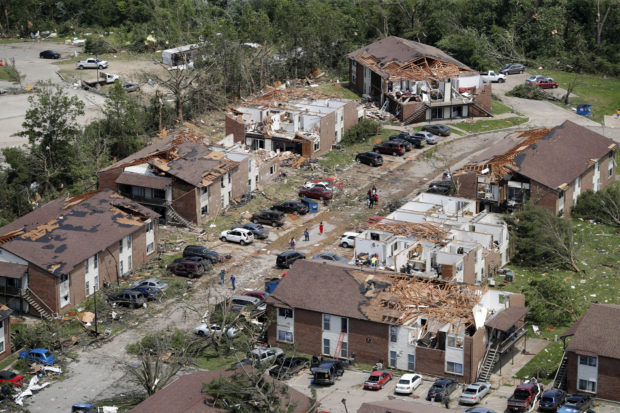Tornadoes strafe Kansas City area in latest spasm of storms
KANSAS CITY, Mo. – A vicious storm tore through the Kansas City area, spawning tornadoes that downed trees and power lines, damaged homes and injured at least a dozen people in the latest barrage of severe weather that saw tornado warnings as far east as New York City.
Parts of Pennsylvania and New Jersey also were under tornado warnings hours after a swarm of tightly packed twisters swept through Indiana and Ohio overnight, smashing homes, blowing out windows and ending the school year early for some students because of damage to buildings. One person was killed and at least 130 were injured.
The storms in Kansas City Tuesday were the 12th straight day that at least eight tornadoes were reported to the National Weather Service.
After several quiet years, the past couple of weeks have seen an explosion of tornado activity with no end to the pattern in sight.
A large and dangerous tornado touched down on the western edge of Kansas City, Kansas, late Tuesday, the National Weather Service office reported.

FILE – In this May 23, 2019 file. Photo, tornado damage is seen in Jefferson City, Mo. Eight years to the day after a devastating tornado killed 161 people in Joplin, another big twister ripped through another Missouri community, Jefferson City, but with a far different result: No deaths, no serious injuries. The two storms share a May 22 date, the same state, and both happened in towns of similar size. Both tornadoes ravaged residential areas and business districts. (AP Photo/Jeff Roberson, File)
At least a dozen people were admitted to the hospital in Lawrence, 40 miles (64 kilometers) west of downtown Kansas City, Missouri, and home to the University of Kansas, hospital spokesman Janice Early said.
Article continues after this advertisementDamage also was reported in the towns of Bonner Springs, Linwood and Pleasant Grove in Kansas.
Article continues after this advertisementBut the Kansas City metropolitan area of about 2.1 million people appeared to have been spared the direct hit that was feared earlier in the evening when the weather service announced a tornado emergency.
Mark Duffin, 48, learned from his wife and a television report that the large tornado was headed toward his home in Linwood, about 30 miles (48 kilometers) west of Kansas City.
The next thing he knew, the walls of his house were coming down.
Duffin told the Kansas City Star that he grabbed a mattress, followed his 13-year-old to the basement and protected the two of them with the mattress as the home crashed down around them.
“I’m just glad I found my two dogs alive,” he said. “Wife’s alive, family’s alive, I’m alive. So, that’s it.”
The severe weather wasn’t limited to the Midwest. Tornadoes were confirmed in eastern Pennsylvania and the National Weather Service issued a tornado warning for parts of New York City and northern New Jersey.
The winds peeled away roofs — leaving homes looking like giant dollhouses — knocked houses off their foundations, toppled trees, brought down power lines and churned up so much debris that it was visible on radar. Highway crews had to use snowplows to clear an Ohio interstate.
Some of the heaviest damage was reported just outside Dayton, Ohio.
“I just got down on all fours and covered my head with my hands,” said Francis Dutmers, who with his wife headed for the basement of their home in Vandalia, about 10 miles (16 kilometers) outside Dayton, when the storm hit with a “very loud roar” Monday night.
The winds blew out windows around his house, filled rooms with debris and took down most of his trees.
Ohio Gov. Mike DeWine declared a state of emergency in three hard-hit counties, allowing the state to suspend normal purchasing procedures and quickly provide supplies like generators and water.
Monday marked the record-tying 11th straight day with at least eight tornadoes in the U.S., said Patrick Marsh, a Storm Prediction Center meteorologist. The last such stretch was in 1980.
The weather service website showed at least 27 reports of tornadoes on Tuesday, most in Kansas and Missouri but also in Pennsylvania and Illinois.
Outbreaks of 50 or more tornadoes are not uncommon, having happened 63 times in U.S. history, with three instances of more than 100 twisters, Marsh said.
But Monday’s swarm was unusual because it happened over a particularly wide geographic area and came amid an especially active stretch, he said.
As for why it’s happening, Marsh said high pressure over the Southeast and an unusually cold trough over the Rockies are forcing warm, moist air into the central U.S., triggering repeated severe thunderstorms and tornadoes. And neither system is showing signs of moving, he said.
Scientists say climate change is responsible for more intense and more frequent extreme weather such as storms, droughts, floods and fires, but without extensive study they cannot directly link a single weather event to the changing climate./gg